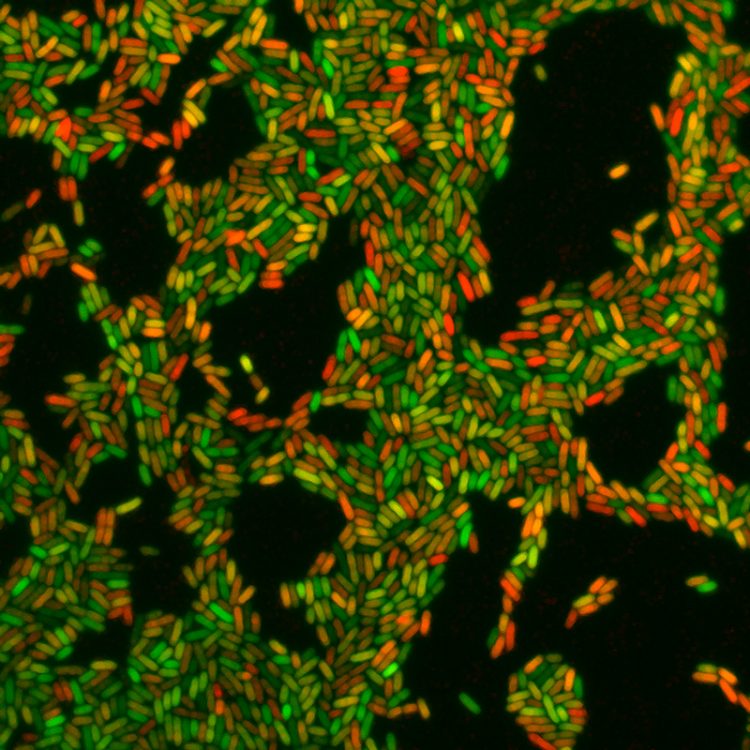Calcium Induces Chronic Lung Infections

Calcium induces a switch from the acute (green) to the chronic virulence state (red) of the pathogen Pseudomonas aeruginosa. Image: University of Basel, Biozentrum
One of the most serious pathogens is the bacterium Pseudomonas aeruginosa, which frequently causes hospital infections and is notoriously difficult to treat owing to its multi-resistance to antibiotics. Although P. aeruginosa is responsible for a range of different infections in humans, it is the leading cause of chronic lung infections in immune-compromised patients.
Calcium induces acute to chronic virulence switch
In an early, acute stage of pneumonia, the pathogen employs a wide arsenal of weapons – so-called virulence factors – to invade the host and evade its immune system. During disease progression, the bacterium adapts its strategy by switching from acute to chronic virulence. It stops the production of virulence factors, such as bacterial injection apparatus and toxins and, instead, produces a protective matrix and reduces its growth rate. The environmental signals directing this transition were so far unknown. The team led by Prof. Urs Jenal, infection biologist at the Biozentrum of the University of Basel, has now identified calcium as a signal that specifically triggers the switch to chronic virulence.
“In Pseudomonas a central signaling pathway senses environmental information and ultimately determines whether the pathogen will undergo the acute to chronic virulence switch,” explains Jenal. “Although the components of this pathway are well-known, none of the external signals modulating the switch are defined.” The researchers have now discovered that a receptor located in the bacterial cell envelope monitors the calcium concentration in the environment and transmits this signal into the cell. Elevated calcium levels trigger the switch to a chronic program: The bacteria protect themselves within a biofilm structure, reduce their growth rate and by that increase their drug tolerance and persistence.
Cystic fibrosis patients harbor calcium sensitive bacteria
Finally, the researchers were able to demonstrate the clinical relevance of their findings. Patients suffering from cystic fibrosis develop lifelong chronic infections by P. aeruginosa, which permanently damage their lung tissue. “Most of the isolates from airways of CF patients have retained their calcium sensitivity,” emphasizes Jenal. “We believe that this allows these bacteria to constantly adapt their virulence in response to the often changing conditions in the airways. One of the characteristics of cystic fibrosis is deregulated calcium homeostasis. We assume that elevated calcium levels in patients promote the switch from an acute to a chronic state of infection. This is of advantage for the pathogen, as it may ensure its long-term survival in the respiratory tract. At the same time, treatment of chronically infected patients becomes more challenging.”
Original article
Ursula N. Broder, Tina Jaeger, Urs Jenal
LadS is a calcium-responsive kinase that induces acute-to-chronic virulence switch in Pseudomonas aeruginosa
Nature Microbiology (2016), doi: 10.1038/nmicrobiol.2016.184
Further Information
• Prof. Dr. Urs Jenal, University of Basel, Biozentrum, Tel. +41 61 267 21 35, email: urs.jenal@unibas.ch
• Dr. Katrin Bühler, University of Basel, Biozentrum, Communications, Tel. +41 61 267 09 74, email: katrin.buehler@unibas.ch
Media Contact
More Information:
http://www.unibas.chAll latest news from the category: Life Sciences and Chemistry
Articles and reports from the Life Sciences and chemistry area deal with applied and basic research into modern biology, chemistry and human medicine.
Valuable information can be found on a range of life sciences fields including bacteriology, biochemistry, bionics, bioinformatics, biophysics, biotechnology, genetics, geobotany, human biology, marine biology, microbiology, molecular biology, cellular biology, zoology, bioinorganic chemistry, microchemistry and environmental chemistry.
Newest articles

A ‘language’ for ML models to predict nanopore properties
A large number of 2D materials like graphene can have nanopores – small holes formed by missing atoms through which foreign substances can pass. The properties of these nanopores dictate many…

Clinically validated, wearable ultrasound patch
… for continuous blood pressure monitoring. A team of researchers at the University of California San Diego has developed a new and improved wearable ultrasound patch for continuous and noninvasive…

A new puzzle piece for string theory research
Dr. Ksenia Fedosova from the Cluster of Excellence Mathematics Münster, along with an international research team, has proven a conjecture in string theory that physicists had proposed regarding certain equations….



